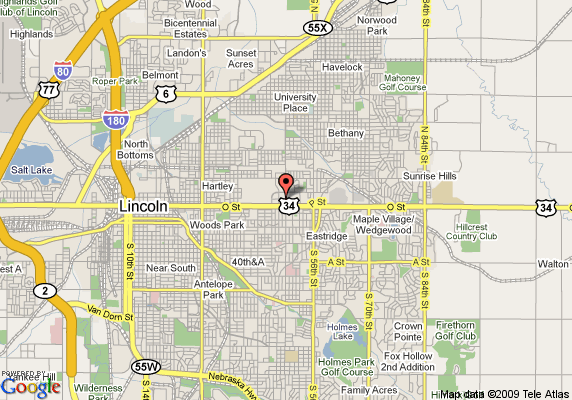The Lincoln housing market in Nebraska is a shining example of the benefits of slow growth. Home price gains and equity appreciation numbers won’t wow anyone, but solid fundamentals are in place to suggest the growth is sustainable. Unemployment numbers are strong, job growth is robust, foreclosures are under control, and the market is highly affordable. All of these add up to an economy that can survive moderate volatility. With continued growth, the Lincoln real estate market can be a model for other U.S. cities to follow.
The current median home price for Lincoln is $150,200. This number is lower than the national average of $203,867. While the Lincoln housing market is below the national average, it has appreciated at a one year rate of 11.4 percent, compared to the national average of 6.7 percent. Over the last 36 months, home prices appreciated 14.7 percent locally, whereas the national figure was over 28 percent. Lincoln real estate is steadily rising at a sustainable pace. Every homeowner and potential seller wants to see an increase in value, but if it happens too quickly it may be artificial. The trend of positive price growth has continued since the recession, and shows no signs of slowing down.
More homeowners in the Lincoln housing market have realized equity gains over the last three years. The same goes for Lincoln real estate investing. While many of these homeowners are not currently looking to sell, the increased equity provides increased options in the future. The following highlights how much equity has been gained relative to the year of purchase:
- Homes purchased in the Lincoln housing market one year ago have appreciated by an average of $17,437, whereas the national average was $15,753 over the same period.
- Homes purchased in the Lincoln housing market three years ago have appreciated by an average of $25,845, whereas the national average was $53,565 over the same period.
- Homes purchased in the Lincoln housing market five years ago have appreciated by an average of $27,345, whereas the national average was $47,444 over the same period.
- Homes purchased in the Lincoln housing market seven years ago have appreciated by an average of $32,297, whereas the national average declined $100 over the same period.
The fact that the Lincoln real estate market was on par or, in some cases, exceeded the national average speaks to the strength of the market.
There are many reasons that Lincoln real estate is so appealing to buy or invest in. The increased market demand may be the most appealing aspect for Lincoln real estate investing. This starts with how attractive an area it is to work in. Over the last twelve months, Lincoln has added over 5,200 new jobs. This number is up from the previous month of 4,800; and greatly outpaces the national market average. The local unemployment rate currently sits at 2.3 percent, which is well below the national average of 5.5 percent. Both of these figures represent a decrease from this same time a year ago. Lincoln also shows great promise in terms of job growth. The area is growing at a 1.9 percent clip, as compared to a national average of 2.1 percent. In terms of unemployment and job growth, Lincoln is one of the strongest in the country. Few cities can boast better numbers. Lincoln real estate investing should benefit as a result.
One of the ways to measure affordability is by the local monthly mortgage payment to income ratio. For the Lincoln housing market, that figure is only 7.2 percent, whereas the national number is 14.3 percent. This provides a level of affordability that most markets do not offer. With more homeowners comfortable in their employment, while having increased residual income, more money is free to move around the market. A stronger local economy leads to increased sales, which ultimately bump up property values.
Another positive sign deals with the amount of new construction inventory on the market. Over the last twelve months, there were 902 new housing permits in the market. This is a slight decrease from the same time a year ago, but it appears the market has bottomed out and is on the way up. Over the past three years, Lincoln far exceeds the national average for new housing permits.
Lincoln real estate investing stands to benefit from the distressed property market. That said, RealtyTrac has identified 119 homes in some state of foreclosure (default, auction or bank-owned). While not high from a national perspective, it is 292 percent higher than it was last year in the Lincoln housing market.
With affordability so high, it is no surprise that the majority (56.9%) of foreclosures are pre-foreclosures. In other words, the homeowners are simply at risk of receiving notice. However, that does not mean the rest of the inventory cant offer great discounts for the Lincoln real estate investing community. The median sales price of a non-distressed home was $137,600. The median sales price of a foreclosure home was $107,950, or 22 percent lower than non-distressed home sales. That is a savings of nearly $30,000 per home.
Lincoln continues to be a stalwart in the real estate market. All markets go through periods of small correction. The best markets use this as a springboard for continued growth. With strong fundamentals and periods of sustained growth, the Lincoln housing market appears to be headed in the right direction.
Lincoln Housing Market Summary:
- Current Median Home Price: $150,200
- 1-Year Appreciation Rate: 11.4%
- Unemployment Rate: 2.3%
- 1-Year Job Growth Rate: 1.9%
- Population: 268,738
- Median Household Income: $52,300

